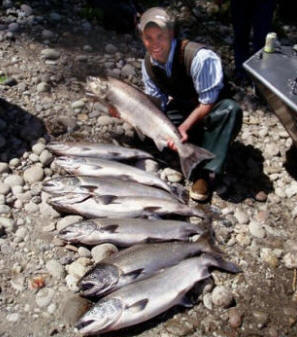forum
library
tutorial
contact

Nearly All Hatchery Fish
Sport Clipped Fins, Says New Report
by Bill Rudolph
NW Fishletter, June 26, 2014
|
the film forum library tutorial contact |

|
Nearly All Hatchery Fish
by Bill Rudolph
|
 A new report completed by the Pacific States Marine Fisheries Commission says that most Columbia Basin hatchery fish now sport a clipped fin, compared to the far lower number of fish marked in 2000. The clipped adipose fin makes it much easier to identify hatchery fish that are spawning with wild fish.
A new report completed by the Pacific States Marine Fisheries Commission says that most Columbia Basin hatchery fish now sport a clipped fin, compared to the far lower number of fish marked in 2000. The clipped adipose fin makes it much easier to identify hatchery fish that are spawning with wild fish.
Marked hatchery fish also allow for implementing selective fisheries, which can boost catches while reducing harvest impacts on returning ESA-listed wild stocks.
Only 43 percent of hatchery fall Chinook were clipped in 2000, but by 2012, nearly 85 percent were clipped, said PSMFC StreamNet Program Manager Chris Wheaton, at the June 11 meeting of the Northwest Power and Conservation Council in Missoula.
He added that about 77 percent of spring/summer Chinook were clipped in 2000, compared to 85 percent in 2012. And 82 percent of hatchery coho were clipped back then, while 87 percent sported a clipped fin by 2012.
Washington Council member Tom Karier, who asked for the updated information, called it a "mostly good-news report."
Wheaton's report noted the complicated marking strategy used in programs such as the Snake River fall Chinook that his simple graphics could not depict. He also said the report did not include information on hatchery programs that may use unclipped fish in supplementation programs to ensure that they are not handled or caught in downstream fisheries. "Many of the fish that are identified as 'unclipped' in this summary may actually be marked with a coded-wire or genetic tag, so that they can be identified as hatchery-origin," said Wheaton, in a letter attached to the report.
By 2012, about 85 percent of more than 135 million hatchery fish released in the Columbia Basin were clipped. The U.S. Fish & Wildlife Service had the best tagging rate for their facilities--nearly 91 percent. State agencies had an 84-percent tagging rate, and tribal programs about 72 percent.
learn more on topics covered in the film
see the video
read the script
learn the songs
discussion forum
